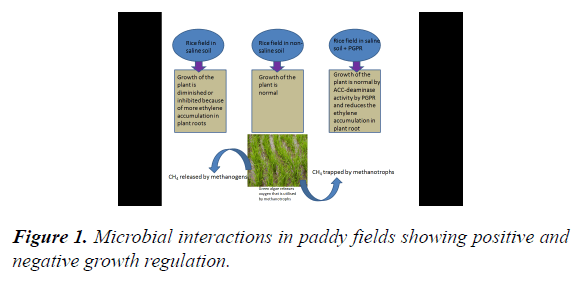Editorial - Journal of Agricultural Science and Botany (2017) Volume 1, Issue 1
Bacterial community interaction with plants: with special reference to Paddy field
Manish Kumar*
Amity Institute of Biotechnology, Amity University, Gwalior, Madhya Pradesh, India
- *Corresponding Author:
- Kumar M
Assistant Professor
Amity Institute of Biotechnology
Amity University
Madhya Pradesh, India
E-mail: mkumar@gwa.amity.edu
Accepted on September 19, 2017
Citation: Kumar M. Bacterial community interaction with plants: with special reference to Paddy field. J Agric Sci Bot 2017;1(1):1-2.
DOI: 10.35841/2591-7897.1.1.34-35
Visit for more related articles at Journal of Agricultural Science and BotanyAbstract
Editorial
Microbes are ubiquitous and cosmopolitan, are associated with plants, animals and to different ecosystems. Microorganisms are the indirect nutrient source for plants, promoting plant growth and development. A number of microbial communities are associated with the plant root system in soil ecosystem [1]. The cropping systems are affected directly by the abundance of microbial entities in this ecosystem. The best example for this type of plant microbe interaction is PGPR (Plant growth promoting rhizobacteria) associated with the plant roots [1-3]. There are several mechanisms that are continuously running in this rhizospheric region that leads to the change in microbial dynamics by the time. This potent plant growth promoting rhizobacterial group has ability to provide several essential and soluble form of metabolites to the plant so that they can achieve a proper and healthy growth [4,5]. The interaction of these microbial communities is beneficial for both microbes and plant as well. Although, there are different cropping system, paddy field is an important crop to study various microbial interactions in its rhizosphereic region along with the microbiome dynamics.
Paddy field is one of the major staple crops of many countries and its yield and production is a major concern as well. Moreover its production is also affected by the availability of water. In developing countries, farmers are still dependent on monsoon for water required for the cultivation of the rice plant. Researchers have elucidated several microbial interactions in the paddy fields. Cyanobacteria, methanogens and methylotrophs other than methanotrophs are interconnected microbial communities in the rice fields. The present editorial is to focus the role of microbial communities in sustaining the paddy ecosystem and involvement of microbial communities in the global carbon and nitrogen cycling by interacting with the plant ecosystem. The methanogenic, methanotrophic and cyanobacterial communities are described and elaborated that how they are interacting in the field.
Rice field is an excellent example of the methane sink [6] and a huge content of the methane gas is released because of the abundance of the methanogenic communities in the flooded rice field [7]. The subsequent chain of microbial transformations induces the release of methane in the paddy field. Subsequently, this enormous methane in the rice field is utilized by the methanotrophic bacterial communities present in the same ecosystem, converting methane into biomass. Therefore methane in the environment is diminished by the methanotrophs present in this flooded rice field. Interesting point is that, the methanotophic activity is triggered by the presence of enzyme mmo (methane mono oxygenase) along with oxygen [8]. This oxygen requirement is fulfilled by the presence of the green algal communities to the surface of the flooded paddy field Figure 1. Since these algal communities are very keen in the release of oxygen, it is trapped by the methanotrophic communities easily that is required for the enzymatic activity of mmo (methane mono oxygenase).
This plant microbe interaction is therefore quite obvious in the paddy field, indicating the balance of biogeochemical cycling also. Three different types of microbial communities are associated in the plant rhizosphere, facilitating the growth of plant positively by mitigating the harmful methane gas.
References
- Meena KK, Kumar M, Kalyuzhnaya MG, et al. Epiphytic pink-pigmented methylotrophic bacteria enhance germination and seedling growth of wheat (Triticum aestivum) by producing phytohormone. Antonie Leeuwenhoek. 2012;101(4):777-86.
- Kumar M, Srivastava AK, Pandey AK. Biocontrol activity of some potent Methylotrophs isolated from Bhitarkanika mangrove sediment. Int J Curr Res Biosci Plant Biol. 2015;2(6):101-6.
- Kumar M, Tomar RS, Paul D, et al. Methylotrophic bacteria in sustainable agriculture. World J Microbiol Biotechnol. 2016;32:120.
- Omer ZS, Tomboloni R, Broberg A, et al. Indole-3-acetic acid production by pink-pigmented facultative methylotrophic bacteria. Plant Growth Regul. 2004;43:93-6.
- Oremland RS, Culbertson CW. Importance of methane-oxidizing bacteria in the methane budget as revealed by the use of a specific inhibitor. Nature. 1992;356:421-23.
- Dubey SK. Microbial ecology of methane emission in rice agroecosystem: a review. Applied ecology and environmental research. Appl Ecol Env Res. 2005;3(2):1-27.
- Singh A, Dubey SK. Temporal variations in methanogenic community structure and methane production potential of tropical rice ecosystems. Soil Biol Biochem. 2012;48:162-66.
- Jhala YK, Vyas RV, Shelat HN, et al. Isolation and characterization of methane utilizing bacteria from wetland paddy ecosystem. World J Microbiol Biotechnol. 2014;30(6):1845-60.
